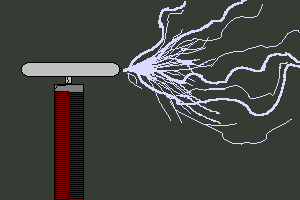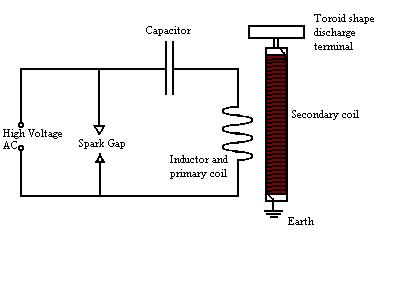
Here begins my rough guide to Tesla coils...
A tesla coil, put simply, is a lightning machine. A Tesla coil creates a high voltage arc of electricity. This is not completely accurate but is not a bad place to start when visualizing the end result of one. The above gif shows to a limited extent what a tesla coil might look like when working. The tesla coil has a large vertical spiral of wire at the bottom which surrounds a smaller but longer spiral of wire which rises from this. The large spiral is called the primary, the thinner and longer the secondary. Only the secondary is visible in the above gif. On top of the secondary is a discharge terminal. This is usually doughnut shaped. It is from this discharge terminal that the lightning is seen to emerge. There’s a whole load of other stuff that you need to work a Tesla coil but I'll go into that latter.
Very well thank you. In more detail then; a Tesla coil is an air cored resonance transformer. If neither of these two explanations help you much then think of it this way... A tesla coil works a bit like a normal transformer. Normal electrical transformers work by using the electric field created by alternating current flowing through a coil of wire. This electric field is also alternating. If a second coil of wire is put in this field an alternating voltage is induced in it. If this second coil of wire is part of a complete circuit then an alternating current results. From this comes the expression of Primary and Secondary to describe the two coils of wire. The primary being the input and the secondary the output. The voltage coming out relative to the voltage going in depends on the ratio of the number of turns on the coils used. If you are familiar with a normal mains to 12 volt transformer for a personal stereo or something, one of those to go from 240Vac to 12Vac would need a turns ratio of 240:12 or 20:1. In other words, the primary would have 20 times as many turns as the secondary. The actual number of turns depends on other things. If only 20 turns was used on the primary and 1 on the secondary then the electric field created by the primary turns would be weak, and the current in the secondary likewise week. To Strengthen this interaction between the two coils many turns are used and these turns are often wound around an iron core. If it was necessary to step the voltage up instead of down, then more turns would be needed on the secondary than the primary. In a tesla coil then it should come as no surprise that a ratio of approximately 1:100 is used, meaning around 10 turns on the primary, and 1000 on the secondary. The input voltage of a tesla coil is usually around 10,000 volts. This is quite high. From the above, an output of around 1000,000 volts would be expected. This is not ,however, exactly what happens. There is another factor at work and this factor is resonance
Almost everyone knows what resonance is. You may not think you do, but you do. Here follows an example;
If you have ever pushed someone on a swing then you understand resonance. Imagine... If someone was sitting on a swing and you wanted to push them you would not just push them at random intervals. If you did this some of your pushes would coincide with the person swinging towards you, and some when they where swinging away from you. Those pushes which coincided with the person swinging towards you would actually slow them down whereas those which coincided with the person swinging away from you would speed them up. Instead you are careful to make each push occur when the swinger is going away from you. This way each push adds to the last and the swinger swings higher than any one push can account for on its own. This is resonance. In this case the swing is resonating with your pushes. You have 'tuned' your pushes so that they occur at the right time intervals to swing the swinger the highest
For this to apply to a Tesla coil there must be in the Tesla coils make up some things that can swing. In the case of a Tesla coil we call this swinging 'oscillating' instead. The two oscillatory components are the tank circuit and the secondary coil. The secondary coils oscillations are fixed, and the tank circuits oscillations are tuned to the secondary until, like the swing, each oscillation or 'push' adds to the last to produce a greater output than any one oscillation or 'push' could account for on its own. In more detail then, the components...

This is a diagram of the tesla coil's circuit. The tank circuit is the part including the high voltage AC, the capacitor, the spark gap and the inductor/primary coil. The current from the high voltage AC source itself oscillates at 50Hz, or 50 times a second due to the mains frequency of 50Hz. This looks like this...
This happens 50 times a second. During the first half of this cycle when the current and voltage are going in the 'upwards' direction on the diagram, the capacitor is charged at high voltage. The voltage inside the capacitor rises during this time. Since the capacitor is in parallel with the spark gap, the voltage across the spark gap is equal to the voltage held by the capacitor. Air becomes conductive at around 30,000 volts per centimeter. The spark gap may be at 1/3 of a centimeter if the supply is 10,000 volts. Once the capacitors hold 10,000 volts, the voltage across the spark gap also is 10,000 volts and this is enough for the gap to spark. As soon as the gap sparks it becomes conductive. The capacitor discharges through the spark gap and recharges itself oppositely to before, again at or nearly at 10,000 volts. The spark takes time to occur and time to disappear. The discharge and recharge of the capacitor happens quickly enough that the spark is still present after the capacitor has recharged. The capacitor discharges again, recharging itself back in the original direction. This repeats thousands of times within the split second that the gap fires for. It stops because of resistance within the wires, capacitor and inductor, and due to other losses. The exact rate or frequency at which this discharging and recharging occurs is defined by the size of the capacitor and the size of the inductor. Once the spark has disappeared within the gap, the capacitor is no longer short circuited and is recharged due to the 'downward' current on the diagram. The process repeats at 50Hz. This then is one of the two things which oscillate within the tesla coil. Since this is driven by the input most directly, this is analogous to the 'push' of the swing. This push must be tuned to the swinger in order for the greatest swing to be reached. The oscillations are passed onto the secondary via the primary coil, which the oscillations pass through and doing so create a rapidly oscillating field which in turn creates current and voltages in the secondary of high frequency.
On the diagram above, the secondary is the taller coil of wire the bottom of which is connected to the earth, and the top to a discharge terminal. The pusher or tank circuit does not directly touch the secondary, instead it generates a field which envelopes the secondary windings. Every swinging object has a rate at which it likes to swing. This is how pendulums can help clocks keep time. The rate at which the secondary like to oscillate is defined by the number of turns of wire on it, its length and width, and the size and shape of the discharge terminal. Very simply, the primary coil must be tuned to push the secondary coil at the same rate as the secondary would like to be pushed. This rate is very fast, usually at radio frequencies. My current coil likes to oscillate at 290 KHz, or 290,000 times a second. If the tuning of the Tesla coil is right very great voltages and frequencies can be produced at the top of the secondary.
Keep in mind that none of the tesla coil actually moves. The 'swinging' is only an analogy for the changing direction of the current and voltage within the wires, capacitors and coils of the Tesla coil.